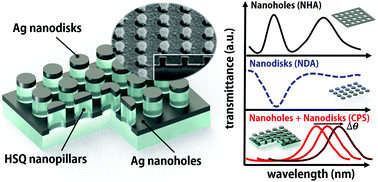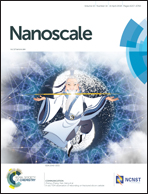Structural coloration of transmission light through self-aligned and complementary plasmonic nanostructures†
Abstract
Structural coloration of natural surfaces often originates from the change of reflected colors depending on the viewing or illumination angle. Recently, the structural coloration of nanoplasmonic structures has attracted a great deal of attention due to high compactness, robust stability and high color-tunability, as well as high sensitivity to the incidence angle. Here we report complementary plasmonic structures (CPS) for transmission structural coloration by tailoring a single spectral peak depending on the incidence angle of light. The CPS features self-aligned silver nanohole and nanodisk arrays, supported by dielectric nanopillar arrays of hydrogen silsesquioxane. Unlike the conventional hybridized nanostructures of plasmonic nanohole and nanodisk arrays, the nanodisks of CPS effectively attenuate undesired spectral peaks of nanoholes by exploiting an extinction peak of nanodisks, serving as a spectral suppressor. As a result, a single transmission spectral peak becomes red-shifted from 736 nm to 843 nm as the incidence angle varies from 0° to 30°. This unique configuration provides a new direction for tunable filters that can be utilized for compact multispectral or hyperspectral imaging applications.



 Please wait while we load your content...
Please wait while we load your content...